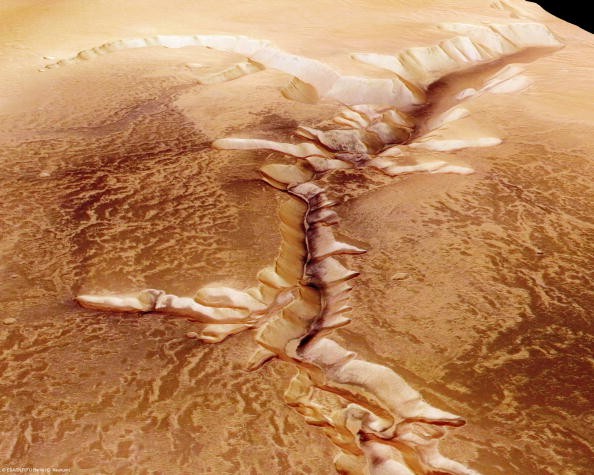Large Tsunamis Once Swept the Surface Of Mars: Scientists
| Cybelle Go | | May 20, 2016 12:38 PM EDT |
(Photo : Getty Images) Scientists say satellite data which shows large sediment redistribution over an area at the northern lowland region of Mars may indicate the there were once oceans and tsunamis on the red planet.
There is scientific evidence that two large tsunamis swept across the surface of Mars.
According to the BBC News, this claim is strongly supported by satellite data, which shows a large sediment redistribution over an area located at the northern lowland region of Mars.
A US-based scientific team has explained that continuous asteroid strikes into a body of water could have caused the huge waves. These tsunamis are believed to have occurred approximately three billion years ago.
Like Us on Facebook
Alexis Palmero Rodriguez, a member of the Planetary Science Institute in Arizona, said that the main implication of this discovery is that to have tsunamis, then there must be oceans.
The findings of Rodriguez and his colleagues appeared in a nature journal named Scientific on Thursday, May 19. The team focused their research on the two regions of Mars, namely Chryse Planitia and Arabia Terra.
There are two events which explain the presence of tsunamis, and these are divided into old and new events.
The older event explains how energetic waves gather the remaining sediments such as boulders that are displaced from a higher elevation. Water, following the principle of gravity, will run downhill thus forming new channels.
The younger event is estimated to have occurred a few million years later when Mars' climate dropped significantly. The waves of tsunami became frozen in time as they tried to spread across the land surface.
The scale of sediment distribution serves as the basis for working out the impact of the tsunamis.
Due to these findings, the theory about the presence of an ocean in Mars is slowly gaining popularity again.
Tagslarge tsunamis, swept, Surface, Mars, scientific evidence
©2015 Chinatopix All rights reserved. Do not reproduce without permission
EDITOR'S PICKS
-

Did the Trump administration just announce plans for a trade war with ‘hostile’ China and Russia?
-

US Senate passes Taiwan travel bill slammed by China
-

As Yan Sihong’s family grieves, here are other Chinese students who went missing abroad. Some have never been found
-

Beijing blasts Western critics who ‘smear China’ with the term sharp power
-

China Envoy Seeks to Defuse Tensions With U.S. as a Trade War Brews
-

Singapore's Deputy PM Provides Bitcoin Vote of Confidence Amid China's Blanket Bans
-

China warns investors over risks in overseas virtual currency trading
-

Chinese government most trustworthy: survey
-

Kashima Antlers On Course For Back-To-Back Titles
MOST POPULAR
LATEST NEWS
Zhou Yongkang: China's Former Security Chief Sentenced to Life in Prison

China's former Chief of the Ministry of Public Security, Zhou Yongkang, has been given a life sentence after he was found guilty of abusing his office, bribery and deliberately ... Full Article
TRENDING STORY

China Pork Prices Expected to Stabilize As The Supplies Recover

Elephone P9000 Smartphone is now on Sale on Amazon India

There's a Big Chance Cliffhangers Won't Still Be Resolved When Grey's Anatomy Season 13 Returns

Supreme Court Ruled on Samsung vs Apple Dispute for Patent Infringement

Microsoft Surface Pro 5 Rumors and Release Date: What is the Latest?












